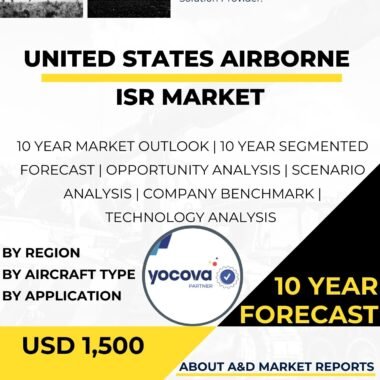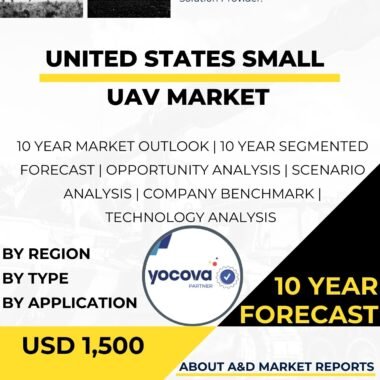Description
Singapore Airborne ISR Market
The Airborne Intelligence, Surveillance, and Reconnaissance (ISR) market in Singapore has experienced significant growth and development in recent years, reflecting the country’s commitment to enhancing its defense capabilities and bolstering its military surveillance and reconnaissance capabilities. Singapore Airborne ISR Market platforms play a crucial role in providing critical real-time information, situational awareness, and intelligence gathering capabilities, allowing Singapore to maintain a vigilant and secure environment. The adoption of state-of-the-art Airborne ISR technology enables Singapore to establish a modern and effective defense posture, contributing to the country’s overall defense preparedness and operational effectiveness.
As a strategically located island nation in Southeast Asia, Singapore faces diverse security challenges, including the need for comprehensive surveillance and monitoring of its territorial waters and airspace. With limited land area and resources, the country has recognized the importance of advanced Airborne ISR platforms to enhance its situational awareness, response capabilities, and overall defense readiness.
The Airborne ISR market in Singapore has witnessed significant technological advancements. Modern Airborne ISR platforms are designed to be highly capable, reliable, and equipped with sophisticated sensor suites, communication systems, and data processing capabilities. These platforms are deployed on various aircraft, including fixed-wing aircraft and helicopters, to conduct a wide range of ISR missions, such as reconnaissance, surveillance, target acquisition, and intelligence gathering.
Moreover, the adoption of advanced Airborne ISR platforms supports Singapore’s commitment to enhancing its defense industrial base and fostering indigenous defense capabilities. The Singaporean government has shown interest in developing and manufacturing Airborne ISR components through local research and development (R&D) initiatives and partnerships with global defense contractors.
The Singaporean government’s emphasis on technological innovation and investment in R&D has positioned the country as a key player in the Airborne ISR market. The nation’s defense industry has actively collaborated with global defense companies to integrate cutting-edge Airborne ISR technologies into the country’s military aircraft.
While the Airborne ISR market in Singapore shows promise, it is not without challenges. One of the primary hurdles is the need for continuous improvement and development of Airborne ISR technology to meet evolving surveillance requirements. As adversaries employ new tactics and technologies, Airborne ISR platforms must adapt and enhance their capabilities to stay ahead of potential threats.
Another challenge is cost-effectiveness. Implementing and maintaining Airborne ISR platforms involve significant investment in research, development, procurement, operation, and training. Budget constraints may impact the pace and scale of Airborne ISR platform acquisition and integration efforts.
Moreover, ensuring skilled personnel and specialized training is essential for maximizing the benefits of advanced Airborne ISR platforms. The Singapore Armed Forces must invest in continuous training and education to ensure their personnel possess the necessary expertise to operate and interpret data from Airborne ISR platforms effectively.
Additionally, Airborne ISR platforms must be fully integrated with other defense systems and networks to optimize their effectiveness. Seamless communication and data sharing between Airborne ISR platforms and other sensors, surveillance radars, and command centers are crucial for successful military operations.
Looking ahead, the Airborne ISR market in Singapore is poised for further growth. The government’s commitment to enhancing its defense capabilities, improving situational awareness, and investing in advanced Airborne ISR technologies will drive continued investments in Airborne ISR capabilities. As Airborne ISR technologies continue to evolve and demonstrate their effectiveness, they are likely to play an increasingly pivotal role in Singapore’s defense preparedness and military modernization.
Moreover, as part of Singapore’s ongoing defense collaborations with international partners, the nation is likely to continue engaging with global defense contractors and Airborne ISR developers to access cutting-edge technologies and expertise.
In conclusion, the Airborne ISR market in Singapore has experienced significant growth and progress. The government’s focus on enhancing its defense capabilities, improving situational awareness, and investing in advanced Airborne ISR technologies has paved the way for the integration of modern Airborne ISR platforms. International collaborations and domestic research efforts have positioned Singapore as a participant in the global Airborne ISR technology landscape.
However, challenges related to technological advancements, cost-effectiveness, training, integration, Airborne ISR platform requirements, and engineering expertise must be addressed proactively to sustain and enhance the growth of the Airborne ISR market in the years to come. By maintaining a modern and effective defense posture with advanced Airborne ISR platforms, Singapore can effectively enhance its defense preparedness, improve situational awareness, and strengthen its overall military capabilities.




